
1956 Melbourne Summer Olympics Official Poster by Richard Beck
1956 Melbourne Summer Olympics, official poster (small format) by Richard Beck, printed in Australia by Containers Limited, Melbourne. Framed and glazed. 57 x 41 cm overall

Australian Football Promotion Package for 1956 Melbourne Olympics
Australian Football At The 1956 Melbourne Olympics: A promotional package produced by the Australian National Football Council to be distributed during the Olympic Games. Included are a'A Primer of Australian Rules', 'Laws of the Australian National Game…

1956 Olympic Games Melbourne Gold Medallists Signed Poster
1956 Olympic Games Melbourne, 'Great Moments' poster with signatures of 13 Australian Gold medallists from the 1956 Olympics including Shirley Strickland, Betty Cuthbert, Lorraine Crapp, Dawn Fraser & Murray Rose; limited edition 421/550 (with certificate…

"Citius, Altius, Fortius, '88" Limited Edition Lithographic Poster
1988 Calgary Winter Olympics Limited edition colour lithographic poster by Ken Wesman, titled 'Citius, Altius, Fortius, '88', numbered 174/288, titled and signed by the artist in the lower margin. Framed and glazed, overall 78 x 88 cm.

Sydney 2000 Olympics & Emery Vincent Limited Edition Posters
A Collection of original Sydney, Australia Olympics 2000 & Emery Vincent, Olympic Arts Festival, Official posters [4]. A series of limited edition posters for the Sydney 2000 Olympics of which one (the runner) was selected by Juan Antonio Samaranch as the…

Cathy Freeman Signed Limited Edition Olympic Poster
2000 Sydney Olympics - Cathy Freeman: 'Reflections of glory - celebrating the Sydney 2000 Olympic Games', limited edition poster by Jamie Cooper, signed by Cathy Freeman and by the artist, numbered #380/2000, overall 53 x 81 cm cm.

Sydney Olympics Poster Collection - 40 As New Examples
The Sydney Olympic Federation Archives - posters: official licensed 'Design poster '006' by Andrew Hoyne' posters in presentation tubes as issued, original retail $29.95 each; 40 examples, as new.

Sydney 2000 Olympic Torch Relay Posters - 40 Available
The Sydney Olympic Federation Archives - posters: official licensed 'Sydney 2000 Olympic Torch Relay' posters in presentation tubes as issued, original retail $29.95 each; 40 examples, as new.

"Share the Spirit" Children's Art Program Posters (39)
The Sydney Olympic Federation Archives - posters: official licensed 'Share the spirit - Children's Art Programme' posters in presentation tubes as issued, original retail $29.95 each; 39 examples, as new.

Official Boxing Posters: 41 As-New Examples
The Sydney Olympic Federation Archives - posters: official licensed posters for 'Boxing', in presentation tubes as issued, original retail $29.95 each; 41 examples, as new.

Official Football Posters from Sydney Olympics
The Sydney Olympic Federation Archives - posters: official licensed posters for 'Football', in presentation tubes as issued, original retail $29.95 each; 35 examples, as new.

Official Volleyball Posters from Sydney Olympics
The Sydney Olympic Federation Archives - posters: official licensed posters for 'Volleyball', in presentation tubes as issued, original retail $29.95 each; 35 examples, as new.

Official Sydney Olympics Athletics Posters (30)
The Sydney Olympic Federation Archives - posters: official licensed posters for 'Athletics', in presentation tubes as issued, original retail $29.95 each; 30 examples, as new.

Sydney 2000 Friendship Poster - Diving Kingfisher
The Sydney Olympic Federation Archives - posters: framed official 'Sydney 2000 - Friendship' poster (with protective lacquer), from the winning image of the 1998 'Share the spirit Children's Art programme showing a diving kingfisher with an olive branch…

Sydney 2000 Field Hockey Official Poster
The Sydney Olympic Federation Archives - posters: framed official 'Sydney 2000' poster (with protective lacquer), promoting the field Hockey events held at the state Hockey centre, Olympic park; mounted on board, overall 87 x 62 cm. Australia's women…

Sydney 2000 Tennis Official Poster
The Sydney Olympic Federation Archives - posters: framed official 'Sydney 2000' poster (with protective lacquer), promoting the tennis events held at the NSW tennis centre; mounted on board, overall 87 x 62 cm. The men's Singles gold was won Yevgeny…

Sydney 2000 Volleyball Poster: Gold Medal Win for Australia
The Sydney Olympic Federation Archives - posters: framed official 'Sydney 2000' poster (with protective lacquer), promoting the Volleyball & beach Volleyball events; mounted on board, overall 87 x 62 cm. Natalie cook & Kerri Pottharst won the beach…

Official Sydney 2000 Baseball Event Poster
The Sydney Olympic Federation Archives - posters: framed official 'Sydney 2000' poster (with protective lacquer), promoting the baseball event held at the Sydney baseball Stadium and Blacktown Olympic park; mounted on board, overall 87 x 62 cm. The USA…
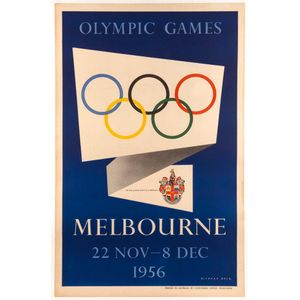
Melbourne 1956 Olympics Poster
Richard Beck (1912 - 1985) Olympic Games Melbourne 28 Nov - 8 Dec 1956, colour lithographic poster, signed in the plate at lower right, printed by containers limited, Melbourne. Laid down on linen, 102 x 65 cm. The iconic full-sized official poster.

Olympics Collection: Cards, Stamps, Medallions, Swap Cards
Olympics selection: with Aoc poster cards: Herald sun poster cards produced to celebrate Australia's 1896-2000 Olympic participation, total of 24 cards (+ album), Sydney 2000 gold Medallists philatelic sheetlets in album (+ a couple of winter Olympics…

Olympic Memorabilia Collection
1988 Seoul Olympics framed presentation of 42 official badges covering all Olympic events 'With the Compliments of Korean Delegation, games of the XXIVth Olympiad Seoul 1988'; souvenir presentation bag from opening ceremony (with placard, radio, raincoat…

Melbourne 1956 Olympics Poster
Richard Beck (1912 - 1985), Olympic Games Melbourne, 28 Nov - 8 Dec 1956, colour lithographic poster, signed in the plate at lower right, printed by Containers Limited, Melbourne. Laid down on linen, 102 x 65 cm. The iconic full-sized official poster.
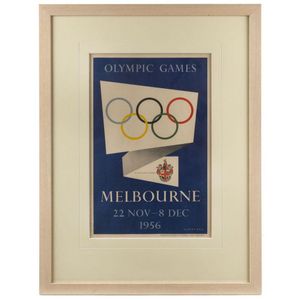
1956 Melbourne Olympics Poster
1956 Melbourne Olympics: official poster of the 1956 Olympic Games in Melbourne, artwork by Richard Beck, showing Olympic rings and Melbourne Coat-of-Arms, small size, 33 x 50 cm, framed and glazed, overall 56 x 75 cm.
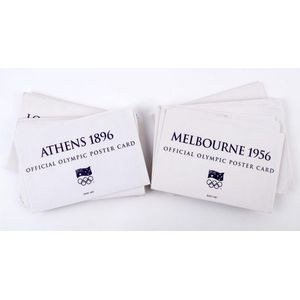
Australian Olympic Poster Cards Collection (1896-2000)
Olympic poster cards: official Aoc (Australian Olympic Committee) poster cards produced to celebrate Australia's 1896-2000 Olympic participation (ex World War I 1916), all years with a duplicate card (ex 1964 Tokyo, single card only), all are in original…
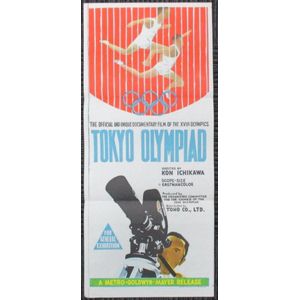
Tokyo Olympiad: Official Documentary of 1964 Games
1964 Tokyo Olympics Daybill Movie Poster 'The Official and Unique Documentary Film of the XVIII Olympics, Tokyo Olympiad, Directed by Kon Ichikawa', overall 33 x 76 cm.
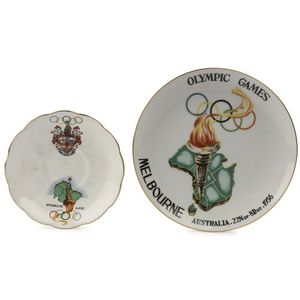
1956 Melbourne Olympics Memorabilia and Magazines Collection
1956 Melbourne: Collection including menu/programme 'City of Los Angeles Salutes the United States 1956 Olympic Team'; 'Olympic Melodies' Ep record; 'Festival of Witness' poster & programme; brochures (10), maps (2), ephemera (c.40) with 'Notice of…

Cathy Freeman Olympic Poster
Cathy Freeman: 'Reflections of Glory - Celebrating the Sydney 2000 Olympic Games', mounted limited edition poster by Jamie Cooper, signed by Cathy Freeman and by the artist, numbered 613/2000, overall 81 x 53 cm.
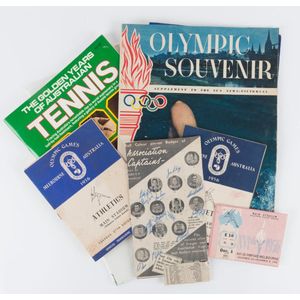
Mixed Sports Memorabilia Consignment
Balance of Consignment: incl. Australian Rules with c.1950 newspaper cut-out signed by Vfa captains Ivor McIvor (Brunswick), Jim Cleary (Port Melbourne, who was heavily involved in the 1945 VFL Grand-Final bloodbath & suspended for 8 weeks) & Pat Bourke…
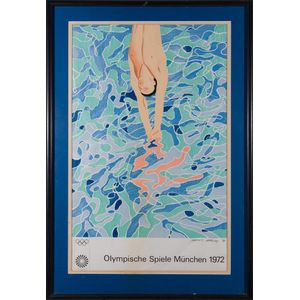
1972 Munich Olympic Games Diving Poster Signed by Matthew Mitcham
A diving poster from the 1972 Munich Olympic Games, from the collection of Matthew Mitcham, signed verso
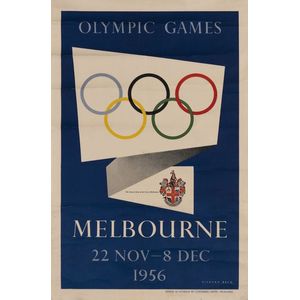
1956 Melbourne Olympics Poster
1956 Melbourne Olympics: Olympic Games/ Melbourne/ 22 Nov - 8 Dec/ 1956', small size poster (33 x 50 cm), designed by Richard Beck. Fair condition (some horizontal creases and small edge fault at right).

Glory of Sport: 1948 London Olympics Film Poster
1948 London Olympics: Movie poster, 'J.Arthur Rank presents, XIV Olympiad, The Glory of Sport. Filmed entirely in Magnificent Technicolor, Produced by Castleton Jnight. Specially Flown to Australia by Qea and Boac'. Printed by We Smith Ltd, Sydney, size…
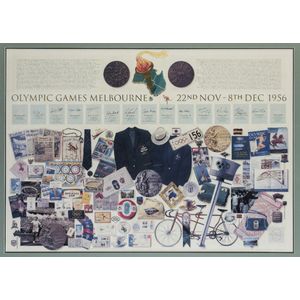
1956 Olympics Australian Gold Medallists Signed Poster
1956 Melbourne Olympics: 'Great Moments' poster with signatures of 13 Australian gold medallists from the 1956 Olympics including Shirley Strickland, Betty Cuthbert, Lorraine Crapp, John Devitt & Murray Rose; limited edition 365/550, framed & glazed,…

Sydney 2000 Olympic $5 Coin Collection and Memorabilia
Sydney 2000 Olympic $5 coin collection. Full album of 28 x $5 card mounted coins. Also Torch Relay commemorative medallion and Daily Telegraph poster album
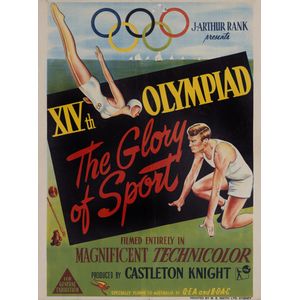
Glory of Sport: 1948 London Olympics
1948 London Olympics: Movie poster, 'J.Arthur Rank presents, XIVth Olympiad, The Glory of Sport. Filmed entitrely in Magnificent Technicolour, Produced by Castleton Knight. Specially Flown to Australia by Qea and Boac', printed by We Smith Ltd Sydney,…

Olympic Memorabilia Collection
Olympics group, Noted 1956 scarf, 1956 'Speedo Swim News' poster no.1, decals 'Member of Australian Olympic Team' & 'Rome Olympics', photographs (5), Mexico '68 Shot-Glass, Cereal Packets (2), Sydney 2000 Cd.

1956 Melbourne Olympics Gold Medalists Signed Poster
1956 Melbourne Olympics, 'Great Moments' poster with signatures of 13 Australian Gold medallists from the 1956 Olympics including Shirley Strickland, Betty Cuthbert, Lorraine Crapp, John Devitt, Tony Marchant && Murray Rose, framed & glazed, overall 96 x…

Olympic Champion Jack Lovelock: A Timeless Tribute
Jack Lovelock Given an Olympic Memorial, poster sized New Zealand hand coloured photograph, image circa 1936, 115 cm, 175 cm
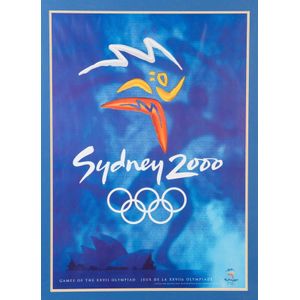
Sydney 2000 Olympics Memorabilia Collection
2000 Sydney Olympics Collection, noted programmes (31). coins. badges/pins. videos. jigsaw puzzle. street banners. various magazines & ephemera. newspapers. Sydney 2000 official poster. Opening Ceremony case & drink cooler (both signed). Prime Minister's…

1956 Olympic Games Gold Medallists Signed Poster
1956 Olympic Games Melbourne, 'Great Moments' poster with signatures of 13 Australian Gold medallists from the 1956 Olympics including Shirley Strickland, Betty Cuthbert, Lorraine Crapp, John Devitt & Murray Rose. limited edition 030/550, window mounted,…

Melbourne Olympiad: Thrilling Film of 1956 Olympics
1956 Melbourne Olympics: Movie poster, 'The thrilling film of the 1956 Olympic Games, Melbourne Olympiad', with handstamp of 'Board of Film Censors/ Malta'.

1956 Melbourne Olympics Poster
1956 Olympic Poster: Official Poster of the 1956 Olympic Games in Melbourne, showing Olympic Rings and Melbourne Coat-of-Arms, designed by Richard Beck, printed by Containers Limited, Melbourne, large size, 64 x 102 cm. Folded, Good condition.

1956 Melbourne Olympics Poster
1956 Melbourne Olympics: Official Poster of the 1956 Olympic Games in Melbourne, artwork by Richard Beck, showing Olympic Rings and Melbourne Coat-of-Arms, small size, 33 x 50 cm. Good condition

1956 Olympics Film Poster
1956 Melbourne Olympics: Movie Poster for 'The Official 1956 Olympic Games Film', window mounted, framed & glazed, overall 57 x 99 cm. Attractive and scarce

The Glory of Sport: 1948 London Olympics
1948 London Olympics: Movie poster, 'J.Arthur Rank presents, XIVth Olympiad, The glory of Sport. Filmed entirely in magnificent Technicolour. Produced by Castleton Knight. Specially Flown to Australia by Qea and Boac', printed by W.E.Smith Ltd, Sydney,…

Australian Post Signed Displays with Olympic Legends & More
Australian Post Displays, noted 'Australian Olympic Legends' poster signed by Shirley Strickland, Dawn Fraser, Herb Elliott, Murray Rose & Marjorie Jackson (some water damage at top); signed displays for Ian Thorpe, Cathy Freeman & Susie O'Neill; other…

1956 Olympic Games Melbourne Gold Medallists Signed Poster
1956 Olympic Games Melbourne, 'Great Moments' poster with signatures of 13 Australian Gold medallists from the 1956 Olympics including Shirley Strickland, Betty Cuthbert, Lorraine Crapp, John Devitt & Murray Rose; limited edition 103/550, window mounted,…

Olympic Memorabilia Collection
Olympics Group, noted 1956 Phoenix Biscuits tin; 1956 'O' cial film Unit - All Venue Pass'; Shell Olympic posters set (12); Olympic Legends FDCs (6); 2000 Sydney flag; 2000 Sydney street banner; also Socceroos child's shirt & trousers; 'World Football…

Ansett Poster Collection: Olympics, Planes, and Travel Prints
Ansett posters: posters collection, noted one Sydney Olympics poster showing Boeing 747 Vh-Ana in its Olympic livery over Sydney Harbour, size 100 x 70 cm. Posters (6), showing Ansett 'Roplanes in flight, each 99 x 69 cm. Travel posters/prints (4), -…

 Loading more...
Loading more...